
Бесплатный фрагмент - Artificial intelligence with a human face
How neural networks build emotional connections with customers
Introduction
Modern science perceives emotions as not merely subjective experience or reaction to stimuli, but as a fundamental mechanism in perception, thought, and decision-making. They are formed under the influence of a multi-level interaction of biological, cognitive, and social processes, and play the role of human adaptation to the world, and behavior regulation. On the physiological level, they represent a system of neural and hormonal responses that ensure the body’s quick adaptation to the environment (fig. 1).
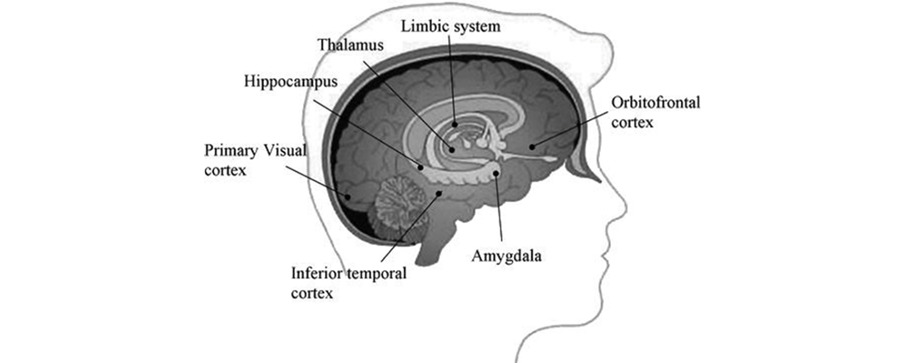
Figure 1. Physiological basis of emotions [1]
The limbic system, a group of structures, is directly implicated in the process. Primary emotional processing of information is performed by the amygdala, and it is highly involved in fear, pleasure, and aggression responses. It automatically evaluates incoming signals and transmits them to other areas of the brain, eliciting the corresponding physiological response. For example, if a person perceives a potential threat, the it activates defense mechanisms — fast heartbeat, rush of adrenaline, increased alertness.
Hippocampus serves as an interface between emotions and memory. It is because of this structure that emotionally significant events are remembered more than neutral events. This is why memories based on intense experiences last longer and can influence future decisions.
The hypothalamus regulates the physical expression of emotions by managing stress and pleasure hormone balance [2]. It is also responsible for keeping emotions in sync with the physical response of the body: changing breathing patterns, facial expressions, and motor movements.
Emotions, thus, are not random or irrational responses, but a complex biological process through which one is able to make a rapid assessment of the circumstances, learn from the past events, and adjust behavior according to the circumstances. But their function is not merely to direct the individual’s perception. People always estimate other individuals’ responses, which help in establishing relationships, determining motives, and exercising self-control. This is particularly necessary in social interactions, where learning to understand others’ feelings serves as the platform for social life and adjustment.
They also serve as an essential communication tool. Facial expressions, gestures, and the tone of voice convey emotions and allow people to communicate without having to speak. For example, a smile is universally recognized to be a welcoming sign, and a scowl suggests discontent or anxiety.
Neurophysiological experiments confirm that all this talent owes its existence to the activity of mirror neurons — special cells of the brain which react not only when a certain action is executed, but also when one witnesses someone else performing it [3]. With their help, we can sympathize, read other individuals’ emotional states, and modify conduct according to situation.
The ability to feel and get the sense of others’ reality is not merely social but is also involved in decision-making. Up to now, it was believed that this process is built on rationality and that feelings interfere with the objective mind. Modern research has a different evidence.
The studies by neuropsychologist Antonio Damasio revealed that individuals who lost the ability for feelings due to prefrontal cortex damage have serious difficulties with decision making [4]. Even when they possess the complete rational view, they are not able to make a decision on what choice is preferable because their brain is not able to take into consideration the consequence of the decision. This indicates that emotions play a vital function in effective decision-making because they allow the brain to predict future outcomes and impart meaning to multiple options.
Therefore, when a person is faced with a series of options, he does not just weigh their advantages and disadvantages, but also which of them are positively associated. This concept is very much relevant in advertising. Consumers do not just choose logically but are also swayed by their emotions. This is especially seen in impulse purchases. This definition of the behavioral component is based on some of the well-known theoretical models that explain the nature and functions of emotions from the point of view of different scientific approaches. Cognitive, evolutionary, and social theories are the most important ones.
The cognitive approach emphasizes that emotional reactions are not automatic or simply physiological but are built on the basis of what an individual perceives and comprehends is happening. According to him, they come about as a result of an inner cognitive analysis of the significance of an event in relation to an individual’s objectives, values, or past. The same external stimulus can evoke opposite emotions in different individuals exactly because each person appraises the situation to himself. The most significant theory is that of Richard Lazarus, which argues that emotions are not a reflex to stimuli but rather the result of a cognitive assessment of an event’s relevance to an individual.
Here, a person takes into consideration what is happening according to a set of parameters. To start with, how significant an event is to its goals and needs, i.e., significance. Second, how much it is in his control, i.e., controllability. Third, who is the agent, and what are the means to combat the consequences. This judgment is either aware or routine. It determines what emotion is to be triggered, to what extent, and for how long.
The application of this theory in the context of brand interaction and marketing communication makes it possible to explain why the same visual, textual, or auditory stimuli generate different emotional responses in various consumers. One and the same ad, addressing family values, can evoke a cozy sense of love in one individual and annoyance or indifference in another, based on individual life experience, actual state and goal structure. For marketers, the theory offers a general cognitive model enabling them to construct more precise and personalized emotional experiences.
Evolutionary theories describe emotions as adaptive reactions programmed biologically by natural selection. They are, in this view, not accidental or redundant expressions of the psyche but perform basic functions for survival and adaptation of the organism to the environment. They are considered universal signaling mechanisms that facilitate threat avoidance, resource approach, social bonding, and behavioral regulation.
Particularly important in this tradition is Robert Plutchik’s model, which has been referred to as the «dynamic wheel of emotions». Eight basic emotions are recognized by her: joy, trust, fear, surprise, sadness, disgust, anger, and expectation. These can combine and become intensified into more complicated emotional experiences.
Social and constructivist explanations focus on the interpersonal and cultural nature of emotions, considering them not as inherent biological reactions, but as the result of socialization and the learning of norms embraced by a specific society. According to these theories, they are not just felt, but also constructed, regulated, and displayed in consonance with social roles, contexts, and cultural scripts. One of the most well-known advocates of this trend is Arlie Russell Hochschild, who developed the terms «emotional work» and «emotional norms», proving that there are clear social rules about what it is acceptable to feel in a specific situation.
Within the framework of these theories, they are taken to be things socially constructed controlled by external criteria and internal dynamics of self-restraint. The individual learns to feel and exhibit his feelings so that they reconcile with accepted criteria — not that he feels thus «by nature», but simply because it is customary to do so in his world. In the practical sense, this means that universal emotion models can be unable to act if they do not take into account cultural specifics. This is a weighty task for marketing: to not only learn to «recognize» the emotions, but also to properly understand them based on the socio-cultural context.
Cumulatively, these approaches determine that emotions are not physiological or instinctive events, but multi-dimensional events located at the interface of society, body, and mind. This understanding forms the basis for the framework to examine engagement in marketing. People choose a particular brand out of a range because of trust, affection, or familiarity with the brand without realizing it consciously. As much as 95% of purchasing decisions are made subconsciously, Harvard Business School professor Gerald Zaltman’s research suggests (fig. 2).
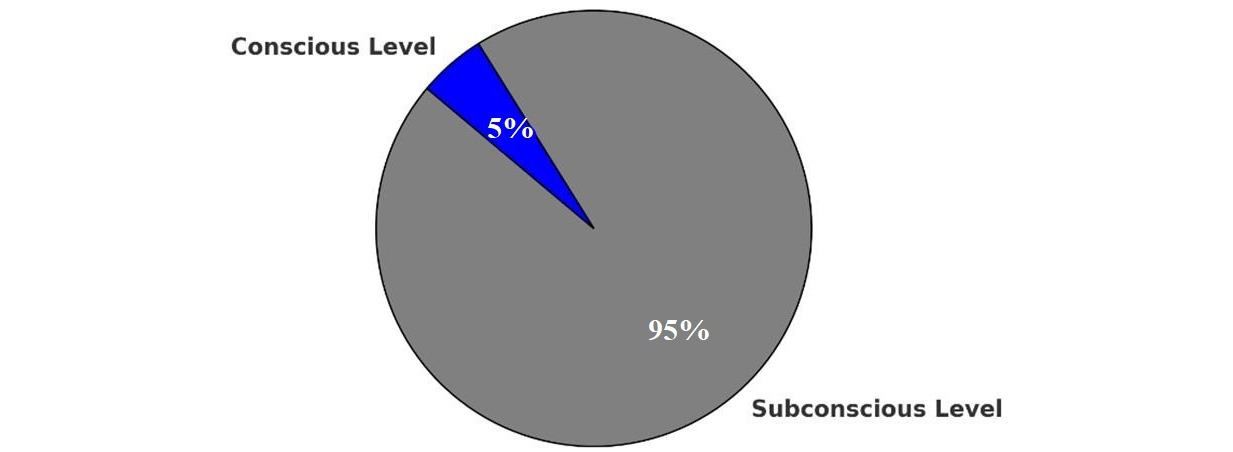
Figure 2. The role of subconscious and conscious levels in decision-making [5]
It is for this reason that the majority of successful ad campaigns rely on emotional advertising rather than purely factual product features. They aim to build long-term connections that bring favorable feelings with every interaction with the brand.
Advertising has been elevated nonetheless in recent decades with the deployment of artificial intelligence (AI) technologies. Among marketers surveyed by HubSpot, 64% of the international respondents are using AI already, and the remaining respondents plan on deploying it soon (fig. 3).
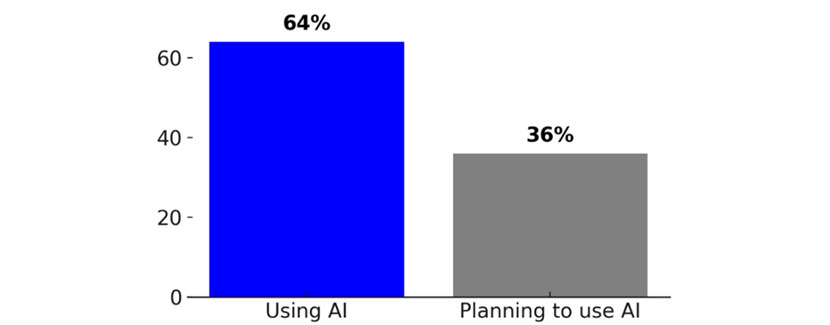
Figure 3. Adoption of AI in marketing [6]
This is a whole new mode of interaction between brands and their publics. Previously, marketing was based on mass campaigns aimed at a wide audience, but today they can offer an individual approach that takes into account not only the preferences, but also the mood of the user at the time of interaction.
One of the most powerful trends in this space is employing AI to decipher emotions. New algorithms are able to understand the human condition through analyzing face movements, speech intonations, text messages, and behavior patterns [7]. Companies can personalize communication according to the condition of the client through this to make interactions easier and more convenient. This use is most stressed in customer care. Chatbots and voice assistants are already able to determine message tone and adjust the communication style, accordingly, depending on the emotions of the user.
Emotion analysis is also being used nowadays in the advertisement field. Technology based on AI can pilot-screen marketing content to see what picture, word, and shade of color registers the most level of audience interaction. Not only can it be done for maximizing campaign efficiency, but it can also render marketing more natural and subtle.
Another vital area is the application of AI in personal recommendations. Companies do not merely consider watching or purchasing history but also where and when the user decides. If the system understands that a person listens to relaxing music at night or enjoys high-energy music during the morning, it can suggest music based on their mood. All of which makes brand interactions more human, more personalized, more emotionally charged [8]. Technologies AI are no longer automation tools per se — now they are becoming go-betweens between the brand and the audience, facilitating the illusion of real, human communication.
Thus, personalization and emotional marketing are no longer trends but a new reality where brand success is no longer determined solely by product quality but also by the ability to establish meaningful, trusting, and emotionally engaging relationships with the audience. In this process, AI has a critical role to play as it helps businesses to better understand customer needs and align their strategies in a manner where each touchpoint generates not just interest but an emotional reaction that is genuine.
Chapter 1. Emotions and marketing: the basis of interaction
Modern consumer behavior is increasingly driven by reason no longer, but through the prism of emotional perception. Consumers do not buy products — they choose the experience, associations, and feelings that accompany the brand. In a situation of high competition and similarity in product characteristics, emotions are the decision driver of differentiation. This makes marketing based on them especially important. It not only allows brands to differentiate, but also to form an enduring connection of the audience. Therefore, it is important to talk about why emotions are such a significant part of decision-making and how marketing can capitalize on this process to form a profound connection with customers.
1.1 Why emotions work better than facts
Perception of brands, products, and advertising messages is not always based on rational analysis and logical argumentation. Modern research in neuropsychology and marketing attests that emotions are a decisive factor in consumer behavior, shaping preference and eliciting loyalty [9]. Emotional responses occur prior to a human becoming aware and processing information on a rational level, and therefore emotions are a significant factor in marketing success.
This process is associated with the functioning of the human brain. Information processing begins with arousal of the limbic system, i.e., emotional reactions. Rational processing appears subsequently — once an emotional response has already arisen. Functional magnetic resonance imaging studies have demonstrated that observing emotionally affecting ads activates similar regions of the brain as watching an actual occurrence [10]. Thus, information that evokes strong feelings is remembered better and has a stronger influence on consumer behavior.
This effect explains why emotions work better in marketing than facts. Even if a brand offers a product with unique characteristics, consumers do not always appreciate its objective advantages — instead, they rely on strong associations. A clear confirmation of this is a study that showed that 70% of the consumers involved spend twice as much on purchases [11].
Emotions serve not only as a trigger for decision-making but also influence long-term memory of brands and advertising campaigns. Research shows that charged events are retained in consumers’ memory 2–3 times longer than neutral ones. The practical application of this mechanism is reflected in the advertising campaigns of large brands [12]. For example, storytelling adverts connect with people on a more emotional level than regular adverts. Storytelling adverts that touch the heart with empathy, joy, or inspiration make consumers not only remember the brand but also associate it with their personal experience.
This impact is being highly exploited in the advertising industry. The American firm Nielsen conducted a study and confirmed that advertisements that evoke high emotions increase sales by 23% [13]. Moreover, buying behavior is influenced not only by current emotions, but also by those expected in the future. Thus, brands try not only to match the current state of the customer, but also to sell future feelings such as comfort, security, or joy. Fear is one of the most powerful motivators. This emotion encourages action and the search for solutions. In advertising, it can be expressed by emphasizing the negative consequences of inaction, for example, «The offer is valid for only 3 days».
In addition to influencing memory and decision-making, they simplify the cognitive processing of information. According to the concept of «cognitive ease», proposed by Daniel Kahneman, the brain strives to minimize energy expenditure when processing data. In this context, emotionally colored information is perceived more easily and quickly than complex logical arguments (fig. 4).

Figure 4. The concept of cognitive ease
This mechanism becomes evident when choosing between similar products. If one brand evokes an emotional response and the other does not, the consumer is much more likely to choose the first, even if the second objectively surpasses it in features.
Emotions play a central role in marketing strategies, shaping not only consumers’ immediate reactions but also long-term brand attachment. They create strong links which have a longer memory span than raw facts and influence the buyer’s choice substantially. In times of information deluge, such an emotional connection aids companies in differentiating themselves from competitors, attracting audience participation, and motivating action.
Not only do brands attempt to bring consumers certain sensations, but also set people in motion with some style of living experience. They construct associative meanings along with the product as a quintessential element in some comfort feelings, achievement, security, or inspiration. And here, fear, happiness, nostalgia, and belonging kindle as some appealing manipulation instruments inducing the people into making those unconscious decisions.
This form of emotional programming of perception is increasingly relevant as the nature itself of marketing strategies evolves. Today, attention is being given less to rational persuasion and more to the creation of an integrated experience that reflects the values, lifestyle, and deep-seated expectations of the consumer.
The contrast between traditional and emotional marketing clearly illustrates how the focus in advertising strategies has shifted — from logic and facts to feelings and personal engagement. Table 1 presents a comparative overview of the main differences between these approaches.
Table 1. Comparative analysis of traditional and emotional marketing
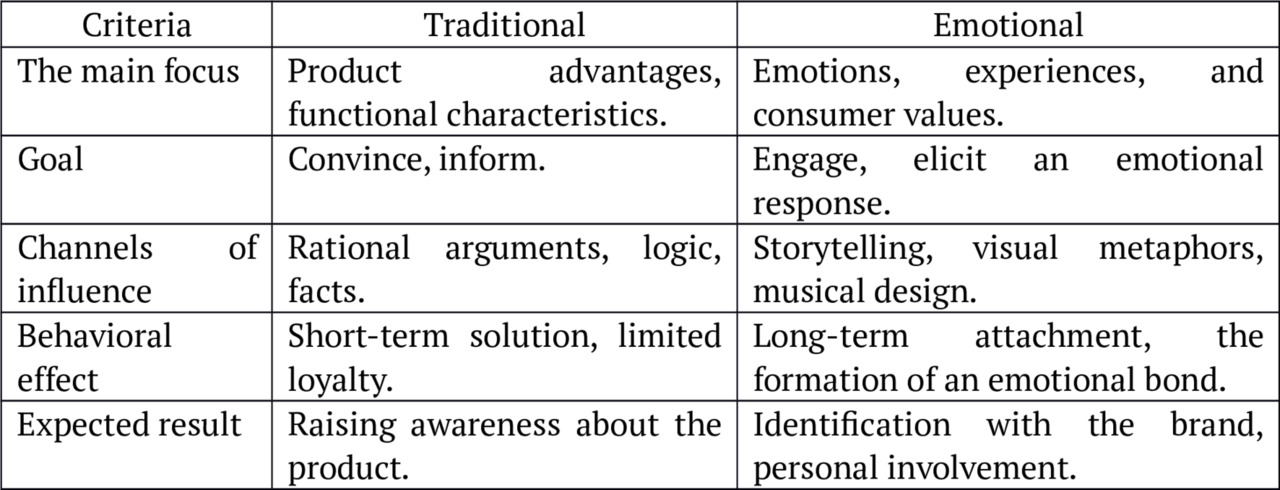
The effectiveness of the emotional approach is also confirmed in practice — many leading brands focus specifically on creating an emotional response. For example, unlike the traditional approach based on describing product features, Nike uses an inspiring narrative that evokes a sense of strength, motivation, and the desire to overcome challenges in consumers.
This strategy is reflected in all aspects of its communication, from visual imagery to the choice of slogans. The legendary phrase «Just Do It», introduced in 1988, became not just an advertising slogan but the brand’s philosophy. The campaign built on this principle turned out to be one of the most successful in marketing history. In the first 10 years after its launch, the company’s revenue increased from $877 million to $9,2 billion (fig. 5).
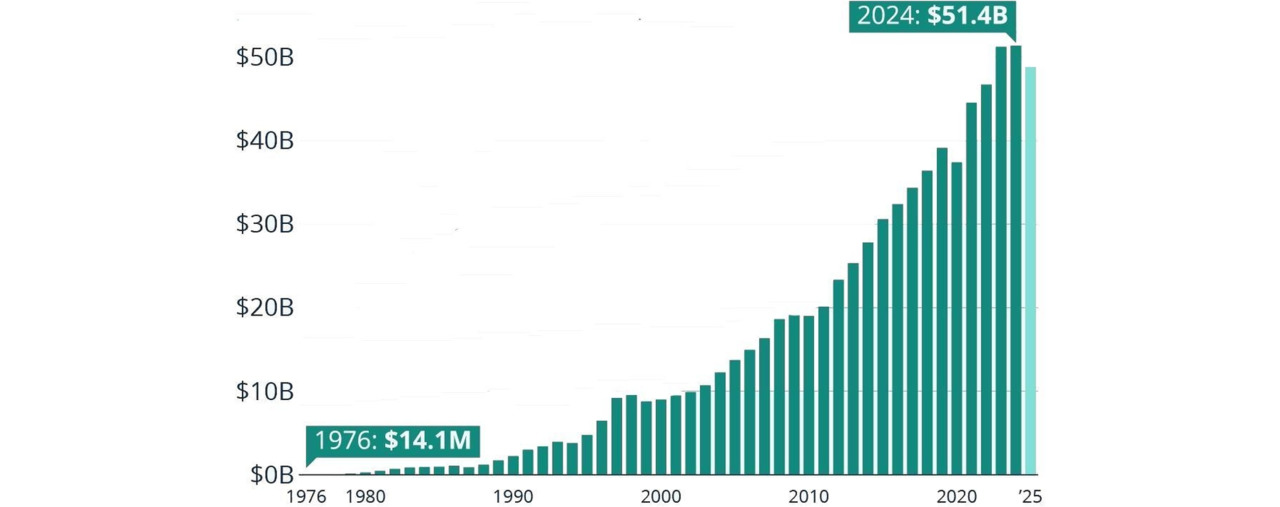
Figure 5. Dynamics of Nike’s global revenue, billions of USD [14]
One of the important techniques used by Nike is engaging the viewer through emotionally rich stories. For example, the company’s advertisements rarely focus on product. Instead, they focus on real or symbolic characters that overcome obstacles and achieve victories. The «Find Your Greatness» campaign became one of the most successful examples of this approach [15]. As opposed to traditional celebrity ads with athletes, the video featured ordinary people achieving small personal victories: a teenager running down a deserted street, disabled people refusing to give up. Due to the campaign, the brand gained 57,000 new social media followers, which speaks of greater user engagement and more effective communication with the target audience. Moreover, the strategy positively affected the financial performance of Nike.
The ad itself was also extremely popular. On the first day itself, it reached the number one position on YouTube and received huge coverage on Twitter as the hashtag #findgreatness was used repeatedly. The campaign was broadcast on television in 25 countries, which served to provide it with a broader global audience and solidify Nike’s grip in the global market [16]. Here, identification with the heroes was a very strong emotional stimulus — there was a strong personal involvement with the message of the brand for the audience.
Another important example is the «Dream Crazy» ad campaign featuring Colin Kaepernick, an American football player who protested racial discrimination. The advertisement bore the following slogan: «Believe in something. Even if it means sacrificing everything». Despite the public’s mixed reaction and boycotts from some consumers, the advertising campaign was a huge success. In the initial 24 hours of the video being released online, the campaign had received millions of mentions, shares, and comments across various platforms. Sales were up by 31% within a week. This case demonstrated that brands that engage deep emotions and engage the audience in meaningful conversation derive not just a temporary effect but create a long-lasting connection with their target audience [17].
Another example is the Coca-Cola Company, whose advertising strategy is rooted in a completely different emotional foundation, highlighting joy, friendship, family tradition, and nostalgia. Perhaps one of the most recognized examples is the holiday season Christmas campaign featuring red trucks covered with holiday lights, instantly associated with the holiday season [18]. This image, which has since become iconic, instantly took roots in popular culture, and from then on, the company uses it annually to re-emphasize its emotional bond with clients.
Another successful example is the «Share a Coke» campaign, where the company replaced its usual logo on bottles with people’s names. This innovation was intended to create a personal connection with the consumer, thus emotional loyalty. In USA, the campaign brought a sales boost of more than 2% for the products bearing the personalized labels. In addition, it created brand awareness: consumers shared photos of personalized Coca-Cola drinks on social networking platforms, thus generating buzz for the campaign. It was also reported that the campaign stopped a downward trend in soft drink sales that had persisted for more than a decade [19].
The company also uses nostalgia as an explicit advertising technique. It has been shown to make individuals feel safe and secure, and therefore more likely to purchase. That is why the company likes to reminisce — whether through classic bottle form, retro-style in advertising, or recycling past slogans.
Both instances demonstrate that good marketing is not rooted in logic but in creating an emotional experience. Nike is about motivation, victory, and overcoming adversity, getting consumers invested in a story of adversity and triumph. Coca-Cola, conversely, induces feelings of joy, warm family moments, and nostalgia, making its brand synonymous with friendship and celebration.
An element that has a direct bearing on customer loyalty is creating an emotional connection between brand and consumer. If the consumer feels positive upon engaging with the brand, then not only are they more likely to buy, but to remain a long-term advocate. This create a sense of personal involvement, and the brand now becomes a fundamental part of who the consumer is. There are many mechanisms whereby they fortify loyalty (fig. 6).
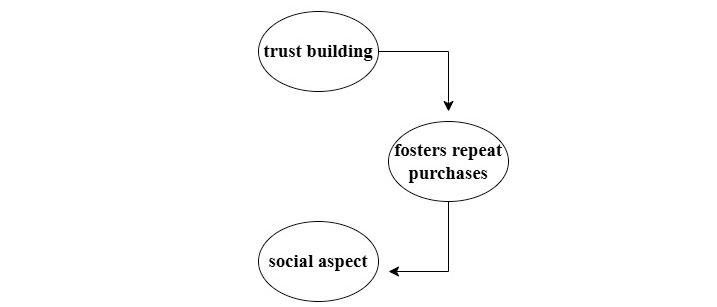
Figure 6. Mechanisms of emotion-based loyalty formation
One of the most important is trust building. By repeatedly eliciting good feelings among its audience, the company is establishing a sense of predictability and reliability. The consumer begins to regard the brand as not only a provider of products or services but also as a friend who understands what they are about and wishes them well.
Second, emotional attachment fosters repeat purchases. People love to return to those brands which previously brought to them some nice feelings in dealing with them. This is especially important in developed markets, where many products and services are of almost the same quality. Under these circumstances, reasoning gives way to personal emotions. Consumers continue purchasing from the company that brings some kind of satisfaction to them despite the presence of some alternatives having the same specifications.
Social aspect also kicks in here. When a brand is capable of evoking strong emotions among its consumer group, it goes beyond its position of a product and enters the sphere of public discourse. People are more likely to comment on such brands, discuss them on social media, and recommend them to others. What follows is a phenomenon of free marketing, where information about the product is shared not through advertising campaigns but through people voluntarily advocating for the brand.
Thus, emotions become the secret to establishing long-term brand loyalty. They establish a unique user experience that not only helps the brand remain in the memory but also makes it an enriching aspect of the consumer’s life. While in a very competitive market, brands that are capable of making their viewers feel true emotional connections gain a significant advantage because loyalty induced through emotions is much more robust than commitment made based on mere logic.
1.2 The role of personalization: from CRM systems to neural networks
Personalization in marketing, as an approach to adapting products and services to the unique needs and preferences of individual clients, began to develop in response to the demand for deeper and more effective consumer interactions. Its evolution has gone through several stages, starting from the early use of databases to modern high-tech solutions based on AI.
The first serious attempts to personalize marketing and customer service can be traced back to the introduction of Customer relationship management (CRM) systems in the 1980. At that time, companies began to recognize the importance of effective customer engagement and the need to store data on each client’s needs, preferences, and purchase history [20]. Such systems became the first significant step in this process. They allowed companies to track data on transactions, customer preferences, and brand interactions, enabling the creation of targeted offers and the optimization of marketing efforts (fig. 7).
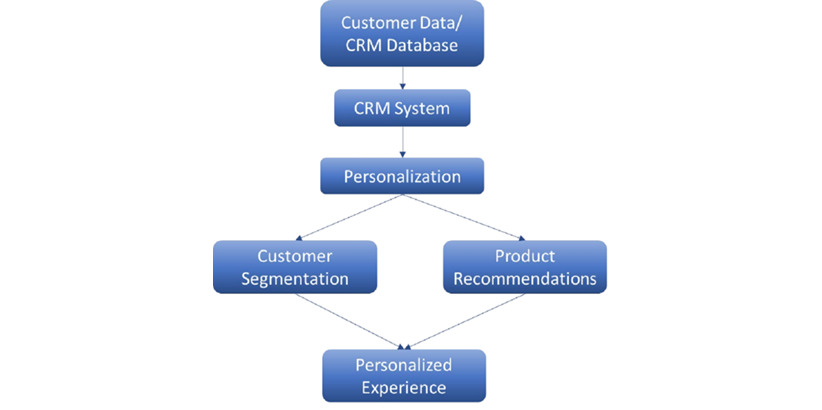
Figure 7. Personalization process using CRM systems
However, despite their importance, CRM systems were limited in terms of flexibility and accuracy. Typically, simple market segmentation methods were used based on basic customer characteristics, such as purchase frequency or product types. Within this approach, personalization remained at the level of basic offers tailored to user groups rather than to each individual client. Their main function was to collect data, not to conduct in-depth analysis. This was an important step toward personalization, but it still did not provide sufficient depth in processing information to predict future customer needs.
In the next stage, personalization took a new form through automated marketing. This became possible thanks to the development of platforms capable not only of storing and processing customer data but also of initiating communications with users based on their actions. During this period, digital marketing began to shift away from universal mass mailings toward more flexible and targeted interactions.
The newly introduced tools enabled automatic messages to be triggered in response to specific events in the user environment. If a customer made a purchase, browsed certain categories, or abandoned a shopping cart, the system could independently respond with an appropriate message — whether a thank-you email, a reminder, or a personalized offer. This approach significantly increased the relevance of communications, as the messages were based on actual consumer behavior rather than assumptions.
However, despite the obvious progress, these scenarios remained predictable and static. They relied on pre-defined templates and could not adapt to changes in context or customer behavior in real time. Interaction with the user was based on simple cause-and-effect relationships, without accounting for nuances such as motivation, temporal preferences, or emotional state. The logic of personalization within automated marketing was limited by pre-established conditions and did not include the system’s ability to learn or self-update.
Nevertheless, this stage marked an important milestone in the history of personalization. It allowed marketing systems to move beyond data storage and toward the active use of data in communication processes. Moreover, it was during this period that the concept of sequence and continuity in the customer journey was introduced — where each client action could prompt a response from the brand. This laid the groundwork for further algorithmic complexity and led to the transition from template-based solutions to intelligent personalization systems capable of analyzing behavior in a broader and more contextually rich framework.
As development continued, the technology reached a qualitatively new level due to the increasing use of machine learning algorithms in marketing strategies. Unlike previous stages, where user interaction was based on fixed triggers and linear scenarios, the new approach allowed for the analysis of complex dependencies between various behavioral parameters and the delivery of individualized solutions in real time.
Recommendation systems became the core of this transformation. Their operation was based on the ability of algorithms to detect patterns not only in the behavior of a single user but also across massive datasets accumulated from millions of others (fig. 8).
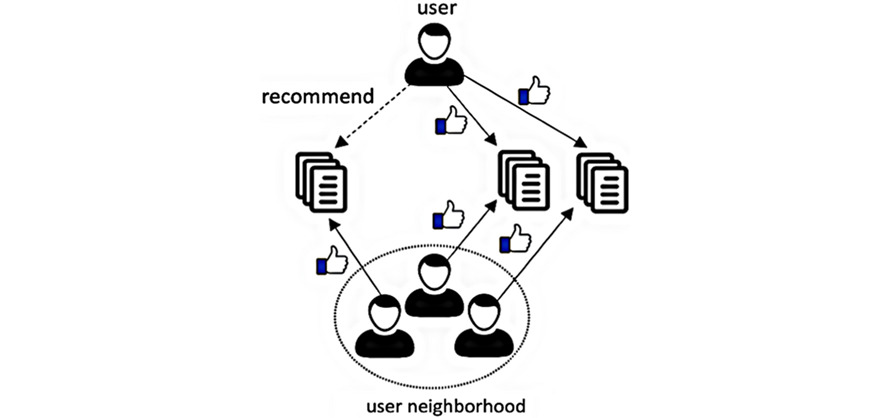
Figure 8. The principle of how recommendation systems work
This made it possible to build personalization not only based on direct indicators — such as «what you purchased» — but also through similarity with other users who performed similar actions, searched for similar content, or displayed comparable activity on platforms. As a result, content, offers, and communications began to be shaped by probabilistic models that take into account the statistical closeness between behavioral patterns.
This type of personalization proved especially effective in areas where the choice of a product or service involves a high level of uncertainty — for example, in entertainment, e-commerce, or streaming content industries. Platforms could suggest movies, music, or products even before the user consciously recognized the need to make a choice, thereby shortening the decision-making process. Moreover, the system considered not only past behavior but also the context of the current session — day of the week, time of day, device used, and duration of interaction. All of this enabled a more finely tuned communication, where the user received suggestions tailored not just to their general interests, but to their current state and expected actions.
User interaction became continuous and synchronized across different touchpoints: website, mobile app, social media, and email. Behavior in one channel influenced recommendations in another, creating the sense of a cohesive, individually tailored customer journey. Personalization ceased to be fragmented and evolved into a systemic adaptation of the brand to the unique rhythm of each customer’s life.
This became possible not only due to the growth of computing power and the accumulation of large volumes of data but also thanks to the increased accessibility of cloud storage and data processing technologies. Companies gained the ability to collect, synchronize, and analyze user data from multiple sources — something that previously required expensive infrastructure solutions. As a result, personalization evolved from a tool for local interaction into a full-fledged mechanism for strategic customer experience management, where every step was planned, predicted, and supported by data.
In the next stage, personalization continued to evolve, shifting from analytical behavior prediction to deep adaptation and interpretation of user context. A key development was the large-scale transition to systems based on neural networks and deep AI architectures. This made it possible not only to process vast datasets but also to work with their internal structure at a new level of complexity, uncovering subtle patterns in behavior, motivation, and emotional responses.
At this stage, personalization became multimodal — it combined textual, visual, auditory, and behavioral data to build a multilayered, dynamically updated user profile. For example, the analysis of text queries in search engines, combined with image or video viewing, as well as data on content reactions (viewing speed, scrolling depth, clicks, pauses), began to be used collectively to more accurately predict interests and intentions. This is no longer just a reaction to behavior — it is proactive modeling of intentions, in which the system strives not only to understand what the user wants, but also why they want it, what state they are in, and which forms of communication will be most appropriate.
Natural language processing (NLP) technologies gained significant importance at this stage. Systems learned not only to recognize queries but also to understand context, intonation, and even the emotional tone of a message. This enabled the creation of personalized dialogues, where the communication style was adapted to the user based on their speech patterns, writing style, or voice responses.
A major shift also occurred as personalization began to take into account not only behavioral and demographic characteristics but also more nuanced psychographic and emotional data. Marketing practices started to incorporate mood and emotional state analysis technologies based on the evaluation of text, audio, video, or even facial expressions. This allowed systems to adapt not only the content of offers but also their presentation: tone, visual design, timing, and delivery channels.
During this period, personalization acquired true cognitive capabilities — that is, the ability to learn, interpret, and predict. Every interaction with the user was used to refine the model of their preferences, interests, and potential needs. This allowed brands to build evolutionary models of interaction that developed in parallel with changes in user behavior, rather than remaining fixed at the point of initial contact.
Interface flexibility played a special role at this stage. Personalization systems began to influence not only content but also form: visual elements, page structure, and layout blocks changed depending on how the user perceived information, what device they were using, their mood, or the specific tasks they were solving at that moment.
Thus, before entering the modern stage, personalization evolved from behavior prediction to contextual and empathetic adaptation based on a deep understanding of the individual (table 2) [21].
Table 2. The evolution of personalization
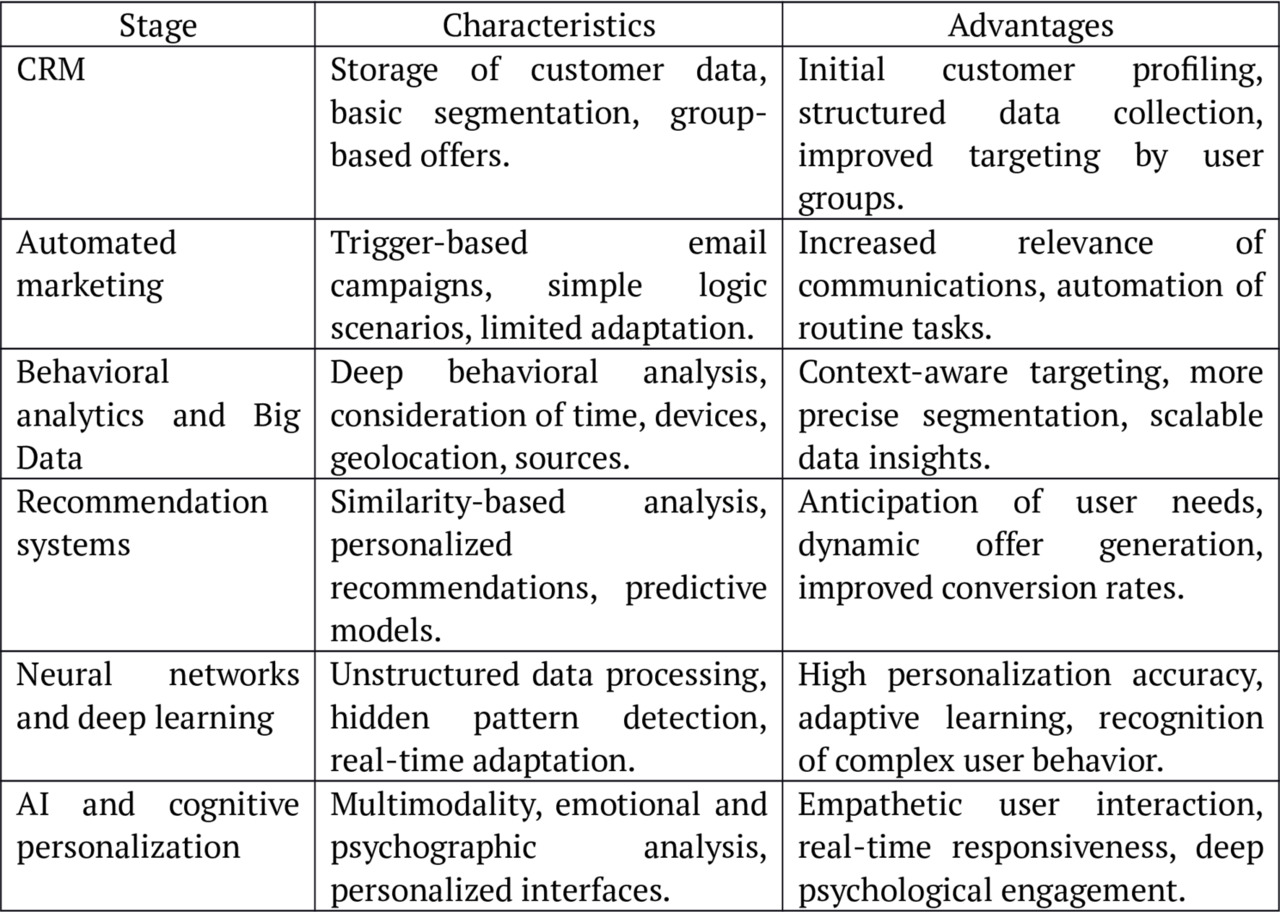
Thus, this is not merely technological automation — it is the transformation of personalization into a form of cognitive interaction between the system and the user, in which decisions are made not only based on logic but also by considering psychological, situational, and even ethical factors. However, these advancements have also brought new challenges.
Modern personalization requires significant computing power and large volumes of data, making it increasingly complex and multi-layered. It is also essential to consider the need for data privacy. In an environment of constant changes in consumer behavior and intense market competition, personalization becomes not only a means of attracting customers but also a necessary tool for retaining them. It enables brands not only to respond to requests but also to create unique and valuable interactions that significantly influence brand perception and market position.
With technological progress, market globalization, and the rapid expansion of digital platforms, customer needs and expectations have undergone substantial changes. In a world where nearly every aspect of daily life is becoming increasingly digital, consumers are no longer satisfied with standard products or services. Instead, they increasingly seek personalized experiences that precisely reflect their individual needs, interests, and lifestyle.
The shift from mass service to an individualized approach has become one of the most significant changes in consumer behavior models over the past decades. This shift is driven not only by the development of technological capabilities but also by changes in how the value of interaction between brand and customer is perceived. There are several reasons underlying the formation of such expectations (fig. 9).

Figure 9. Reasons behind the formation of personalization
The primary reason for this is the rapid development of technologies that enable brands to collect and analyze customer data, as well as the evolving dynamics of interaction between consumers and products. Brands began offering suggestions not only based on past consumer behavior but also on their expectations and current mood. This approach was immediately perceived by users as convenient, allowing them to avoid unnecessary effort in searching for the right content or product. Gradually, this expectation became the norm, extending not only to media platforms but also to various business sectors — from banking services to online retail.
Another factor that shaped this expectation was the information overload faced by modern consumers. In a world of pervasive digitalization and saturated information spaces, consumers are now confronted with an overwhelming number of products and services. In such a context, only the brand that can address individual needs is able to capture their attention.
Additionally, since technologies developed and customized solutions came within reach, these practices had come to be regarded as an obvious thing. Sites like Google and VK that gather enormous amounts of user activity data have been able to get ahead of the users’ wishes and provide just the content that they will want most. This not only made it easier for these services to be used but also affected people’s expectations from all the brands they interact with. People began expecting that businesses ought to provide them with not just homogenous solutions but also unique solutions that reflect their personal taste.
Yet another important contributory factor to the demand for a personized approach is having the sense of being special and appreciated. Where consumers are often overwhelmed in a mass production culture with the same goods and services, they desire to experience that their specific needs and interests are applicable. Personalization can capitalize on this sense of being appreciated, where it can emphasize to consumers that the offer and experience is based on their own, exclusive data. This approach impacts not just loyalty but also emotional brand perception. When customers feel appreciated and listened to, it creates a firm connection with the brand — one that goes beyond consumer interest and is a deeper psychological attachment.
In addition, over the last several years, with growing collective consumer consciousness regarding personal data and privacy, consumers now expect not only that their data will be used by brands to personalize, but that it is done so in a manner respectful of their right to privacy. With personalization becoming the norm, customers find that they are demanding to be provided with some level of insight into how they are handling their data and that they would not trade it to third parties without their consent. This compels customers to push brands not only to apply personalization technologies but to ensure that they are as safe and ethical as possible to users.
The call for personalization, then, is not merely due to a desire for speed and convenience but also because customers increasingly seek not merely a product or service but an experience that resonates with their value system, interests, and lifestyle. The trend calls on companies not merely to adopt new data-collecting and data-analytical technologies but also to be capable of evolving in reacting to shifting demand and taste. In a competitive business environment, those that fail to meet expectations of personalization are likely to fall behind global trends and lose the competitive edge.
Conclusion to chapter 1
Emotions are a key part of marketing and play a significant role in consumer behavior and decision. Neuropsychological studies prove that emotions not only govern short-term reaction but also long-term brand commitment, dramatically increasing customer loyalty. Emotional response is a much more powerful driver of decision than reason or fact, as a variety of research and extremely successful ad campaigns such as those of Nike and Coca-Cola have clearly illustrated. Feelings form connections that remain in the memory for quite a long period and influence the choices of consumers even if they are presented with products of similar kind.
This not only increases sales but also helps build a solid rapport with the brand, producing a sense of engagement and uniqueness in customers. Through the use of emotions in marketing, companies can distinguish themselves from others by positioning their brands as something desirable and consumer centric.
With technological advancement — more particularly the development from basic CRM systems to neural networks — marketing has been made increasingly personalized. It has become a key tool not only for customer acquisition but also for customer retention in a highly competitive marketplace. This development has, however, brought with it challenges related to handling extremely large data and ensuring customer privacy.
As a result, the need for an individualized approach has become a normal component of consumer behavior. Consumers now anticipate not just products and services, but an experience that is suited to their lifestyle and interests. Those companies that can deliver such an approach are already a step forward in a world of global change and rapidly changing market demands.
Chapter 2. AI and emotions: how it works
With the development of AI, one of the most ambitious tasks has become the understanding and analysis of human emotions. Unlike the traditional approach, which often boils down to superficial data processing, modern technologies allow for a deeper comprehension of feelings. As a result, it has become possible to create higher-quality, personalized user interfaces and improve the customer experience. Emotions play no less an important role than information in the process of decision-making, interaction with a product or brand, and therefore the ability of technical devices to perceive and interpret them becomes especially important.
State analysis technologies based on AI are capable of recognizing even those emotions that are hidden behind the external manifestations of human behavior. They are actively used in various fields: from creating personalized recommendations on streaming platforms to improving customer interaction. Their importance is hard to overestimate, as they provide more natural and human-like ways of interaction.
2.1 Neural networks as emotion readers
Modern research in the field of AI shows that emotions have become not only an object of study but also an important element of interaction between humans and machines. A significant question remains how exactly it is capable of «reading» them through the face, voice, and text.
One of the most studied and applied methods is emotion recognition based on facial expression analysis, allowing a person to identify the state of an individual with accuracy. Facial expressions are one of the most expressive and direct indicators of internal emotional states because they have a tendency to show emotions unconsciously and involuntarily. This makes them highly valuable in real-time interaction where voice or verbal cues are unavailable or unreliable.
Scientifically, facial expressions are based on universal muscle movements, as can be seen in the research of Paul Ekman and Wallace Friesen, who developed a system of facial action encoding. It defines specific units of action that build up into emotional expressions that are perceivable. For example, a genuine smile requires the contraction of both the big zygomatic muscle (pulls mouth corners upwards) and the orbicular eye muscle (creates «crow’s feet» around the eyes). It is difficult to fake these physiological reactions consciously, and therefore, they are very informative for emotion recognition systems.
The working principle relies on the observation of various facial features, such as the shape of the eyes, the angle of the lips, the movement of the eyebrows, and other small changes that may indicate a particular state. These changes can be both visible and not detectable by the normal human eye. For their effective recognition, various algorithms are used, each with its own features and applicability in different contexts.
One of the most widespread tools is the convolutional neural network (CNN) [22]. These neural network algorithms, based on the principles of machine learning, enable deep image analysis by extracting various features that play an important role in recognizing facial expressions (fig. 10).

Figure 10. Architecture CNN
They efficiently process visual data, automatically extracting and classifying features such as contours, textures, eye shapes, and corners of the mouth. At a low level, they detect simple elements, while at a higher level — complex patterns such as the shape of facial expressions, which allows for accurate classification of emotions such as joy, sadness, anger, and others. In addition, CNN are spatially invariant, i.e., they can identify expressions of emotion appropriately even when the face is rotated, partially occluded, or slightly shifting in location. They are therefore appropriate tools for real-world applications such as emotion tracking, adaptive user interfaces, and human-computer interaction systems. To improve recognition accuracy, recurrent neural networks (RNN) and long short-term memory networks (LSTM) are often used, as they enable modeling of temporal dependencies (fig. 11).
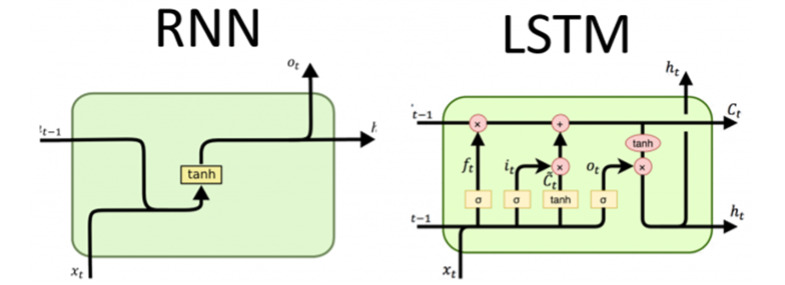
Figure 11. Architecture RNN and LSTM
They can analyze the dynamics of facial expressions by tracking their changes over time, which is especially important in real-life situations where emotions can shift during interaction. For example, recognizing them based on video clips requires accounting for temporal aspects, such as changes in facial expressions during a conversation. They are built to take context and event order into account, and thus are particularly well-suited to dynamic data. In addition, multimodal solutions guarantee a much better accuracy of recognition. Emotions are rarely depicted by the face alone, most of the time they are complemented by voice, gestures, body movements, and physiological states. These models integrate, for example, visual data with auditory data processed through speech parameters and create a richer picture of the emotional state. This procedure helps in preventing interpretive errors and accommodating better the user’s individual and cultural features.
In the emotionally adaptive systems, this integration allows it to possess high empathic accuracy, providing not only emotion detection, but also understanding of its context, reasons, and direction of evolution. This allows the system to dynamically adjust behavior, tone, and type of interaction while interacting with the user.
To classify facial expressions and interpret feelings based on such associations, various machine learning algorithms are actively applied. Among them, support vector machines (SVM) hold a special place [23]. They demonstrate high efficiency when processing well-labeled and linearly separable data (fig. 12).
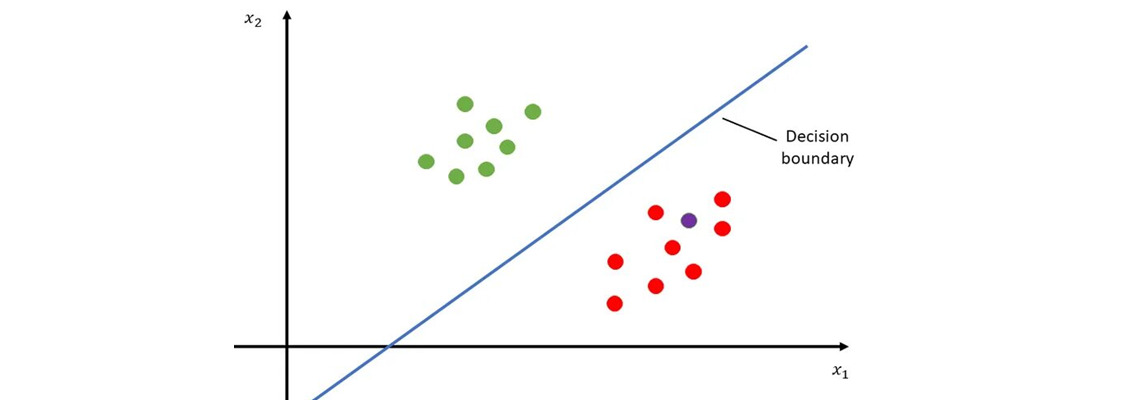
Figure 12. Model SVM for classifying emotional expressions
Their main advantage is the ability to create best separating hyperplanes that maximally discriminate data classes in a multidimensional feature space. It allows you to effectively differentiate between anger, joy, surprise, disgust, and other expressions, even when there are minimal differences in facial patterns among them. The algorithm works by finding a boundary that not only separates classes but also maximizes the distance between the nearest points of different classes, the support vectors. In doing this, it renders the model robust against overfitting, especially for cases where the number of features is small, and the training sample size is limited.
This approach has proved to be good at simple emotion recognition from static facial features. Additionally, it is being successfully integrated with other methods, acting as a last classifier in more complex architectures.
Decision trees are yet another method used in emotion recognition applications. These algorithms are a tree model where every node is the test for some feature, and every branch is the assessment of the logical outcome of this test. Simple and interpretable, they are particularly useful for giving insight into why the system has made a certain decision and are thus particularly useful in high-transparency applications (fig. 13).
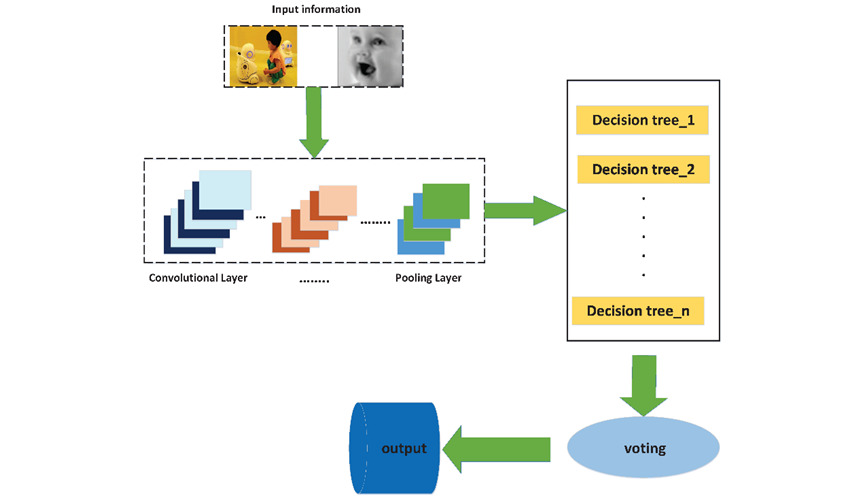
Figure 13. Architecture of an emotion recognition system using a decision tree ensemble
As far as the analysis of facial expression is concerned, this method allows step-by-step determination of the user’s mood using a natural sequence of signs. For example, mouth position, the degree of eyebrow rising, the nasolabial fold depth, direction of gaze and the symmetry of the face. Each sign is investigated as a potential candidate of a particular state of emotion. Therefore, there is a system of rules which enable one to categorize an expression into one of the predefining categories.
One of the major advantages is the ability for high speed of operation, especially in real-time mode. The algorithm sequentially traverses the tree branches and takes one decision at a time, consuming comparatively small computation time and allowing you to analyze promptly incoming signals, for example, from a camera. That is why the method is very applicable in embedded systems, smart devices, and augmented reality systems.
These algorithms have formed the foundation of many modern solutions. The most successful among them have long since transitioned from laboratory prototypes to commercially available products integrated into marketing. In particular, next-generation systems such as Affectiva and FaceReader use not only classical machine learning models but also more advanced neural network algorithms, providing high accuracy in facial expression analysis. They combine the extraction of facial features with deep visual information processing, adapting to a wide range of emotional states and contexts (table 3) [24].
These systems possess unique capabilities for detailed analysis of human emotions through facial expressions. Their common features lie in the ability to account for the dynamics of changes and contribute to the creation of more personalized and adaptive user interfaces. At the same time, each of these systems has its own strengths and can be used in different areas, depending on the specifics of the tasks and the required accuracy of analysis.
Table 3. Comparison of emotion recognition technologies in the Affectiva and FaceReader systems
Бесплатный фрагмент закончился.
Купите книгу, чтобы продолжить чтение.